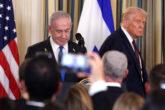June 04, 2018
The Pro-Assad Alliance Is Coming Apart
In a May 21 speech on U.S. strategy following President Donald Trump’s decision to withdraw from the Iran nuclear deal, Secretary of State Mike Pompeo struck a tough tone, promising to confront Iran’s Islamic Revolutionary Guard Corps (IRGC) and its multinational Shiite militia networks throughout the Middle East. But strong words have yet to be matched with action. For years, the United States has struggled to come up with a strategy for containing and eventually rolling back Iranian influence in Syria, the most hotly contested battlefield in the Middle East.
That may be about to change, thanks to an emerging fracture in the alliance backing Syrian President Bashar al-Assad. On one side of the divide is Iran, which seeks to consolidate its gains in Syria in order to apply military pressure on Israel. On the other side are the Assad regime, Hezbollah, and Russia, all of which fear a major conflict with Israel that could undermine what they have fought for in the Levant over the past decade. These divisions may finally provide Washington with the opportunity it has been seeking to check Tehran’s ambitions in Syria.
COMING APART
Assad’s position today is as strong as it has been since 2012, when Syria’s armed opposition first started gaining momentum. Over the past two years, the regime and its allies have made significant territorial gains, especially in the strategic areas in and around the capital of Damascus and in the last pocket of rebel rule in Homs Province. Assad’s opponents lack either the will or the capability to stop him from slowly winning the war.
Read the Full Article at Foreign Affairs
More from CNAS
-
Transatlantic Security / Middle East Security
The Russia-Iran Partnership: A Geopolitical Balancing ActIt has been almost a year since Russia and Iran signed their comprehensive strategic partnership. That deal established a 20-year partnership between the two countries coverin...
By Andrea Kendall-Taylor & Jim Townsend
-
Transatlantic Security / Middle East Security / Energy, Economics & Security
Sanctions Aren’t Enough to Shut Down the Moscow-Tehran Black Market for WarThe geographic scope and extent of Iranian-Russian cooperation highlights the failure of traditional sanctions to prevent Moscow and Tehran from seeking key components like ch...
By Delaney Soliday
-
How a Peace Deal Between Hamas and Israel Will Reshape the Middle East
Rachel Brandenberg joins NPR to discuss how the region will change if Israel and Hamas continue to abide by the peace deal President Trump brokered. Listen to the interview o...
By Rachel Brandenburg
-
Donald Trump’s Gaza Plan Skips Step One
The White House proposal attempts to solve too many distinct issues all at once, without enough input from Palestinians....
By Delaney Soliday




